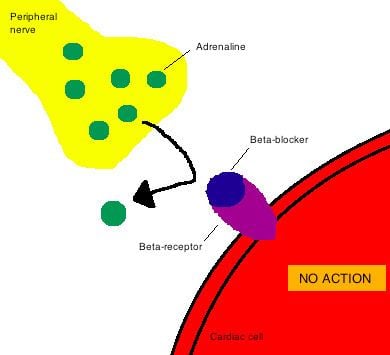 | ||
In pharmacology, the term mechanism of action (MOA) refers to the specific biochemical interaction through which a drug substance produces its pharmacological effect. A mechanism of action usually includes mention of the specific molecular targets to which the drug binds, such as an enzyme or receptor. Receptor sites have specific affinities for drugs based on the chemical structure of the drug, as well as the specific action that occurs there. Drugs that do not bind to receptors produce their corresponding therapeutic effect by simply interacting with chemical or physical properties in the body. Common examples of drugs that work in this way are antacids and laxatives.
Contents
- Drugs with known mechanisms of action
- Aspirin
- Drugs with unknown mechanisms of action
- Versus mode of action
- Microscopy based methods
- Direct biochemical methods
- Computation inference methods
- References
In comparison, a mode of action (MoA) describes functional or anatomical changes, at the cellular level, resulting from the exposure of a living organism to a substance.
Drugs with known mechanisms of action
There are many drugs in which the mechanism of action is known. By knowing the interaction between a certain site of a drug and a receptor, other drugs can be formulated in a way that replicates this interaction, thus producing the same therapeutic effects. Indeed, this method is used to create new drugs.
Aspirin
The mechanism of action of aspirin involves irreversible inhibition of the enzyme cyclooxygenase; therefore suppressing the production of prostaglandins and thromboxanes, thus reducing pain and inflammation. This mechanism of action is specific to aspirin, and is not constant for all nonsteroidal anti-inflammatory drugs (NSAIDs). Rather, aspirin is the only NSAID that irreversibly inhibits COX-1.
Drugs with unknown mechanisms of action
Some drug mechanisms of action are still unknown. However, even though the mechanism of action of a certain drug is unknown, the drug still functions; it is just unknown or unclear how the drug interacts with receptors and produces its therapeutic effect.
Versus mode of action
In some literature articles, the term mechanism of action and mode of action (MoA) are used interchangeably; typically referring to the way in which the drug interacts and produces a medical effect. However, in actuality, a mode of action describes functional or anatomical changes, at the cellular level, resulting from the exposure of a living organism to a substance. This differs from a mechanism of action, as it is a more specific term that focuses on the interaction between the drug itself and an enzyme or receptor and its particular form of interaction, whether through inhibition, activation, agonism, or antagonism. Furthermore, the term mechanism of action is the main term that is primarily used in pharmacology, whereas mode of action will more often appear in the field of microbiology or certain aspects of biology.
Microscopy-based methods
Bioactive compounds induce phenotypic changes in target cells, changes that are observable by microscopy, and which can give insight into the mechanism of action of the compound. With antibacterial agents, for example, the conversion of target cells to spheroplasts can be an indication that peptidoglycan synthesis is being targeted, and filamentation of target cells can be an indication that FtsZ or DNA is being targeted. In the case of anticancer agents, bleb formation can be an indication that the compound is disrupting the plasma membrane. A current limitation of this approach is the time required to manually generate and interpret data, but advances in automated microscopy and image analysis software may help resolve this.
Direct biochemical methods
Direct biochemical methods include methods in which a protein or a small molecule, such as a drug candidate, is labeled and is traced throughout the body. This proves to be the most direct approach to find target protein that will bind to small targets of interest, such as a basic representation of a drug outline, in order to identify the pharmacophore of the drug. Due to the physical interactions between the labeled molecule and a protein, biochemical methods can be used to determine the toxicity, efficacy, and the mechanism of action of the drug.
Computation inference methods
Typically, computation inference methods are primarily used to predict protein targets for small molecule drugs based on computer based pattern recognition. However, this method could also be used for finding new targets for existing or newly developed drugs. By identifying the pharmacophore of the drug molecule, the profiling method of pattern recognition can be carried out where a new target is identified. This provides an insight at a possible mechanism of action, as it is known what certain functional components of the drug are responsible for interacting with a certain area on a protein, thus, leading to a therapeutic effect.
